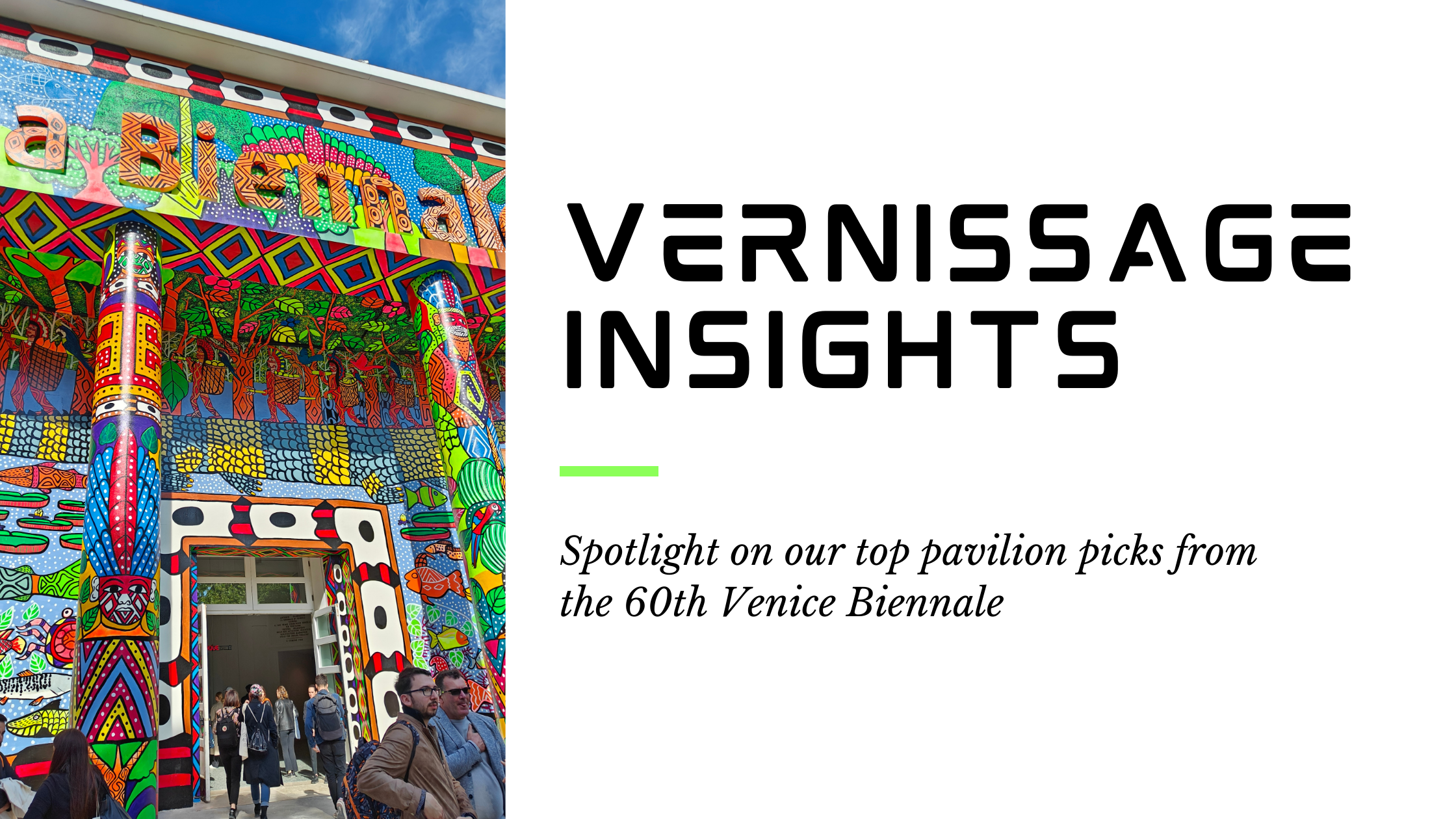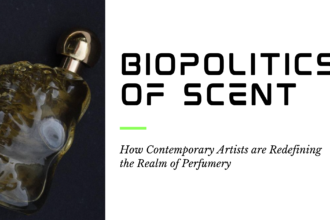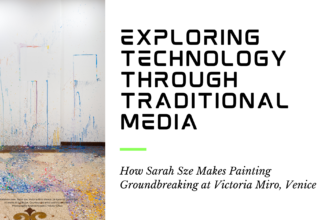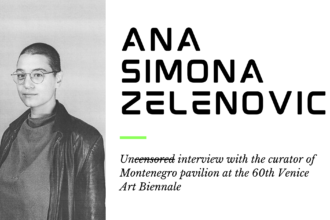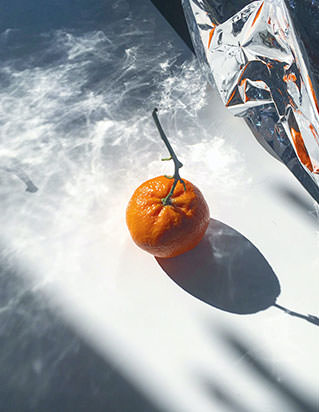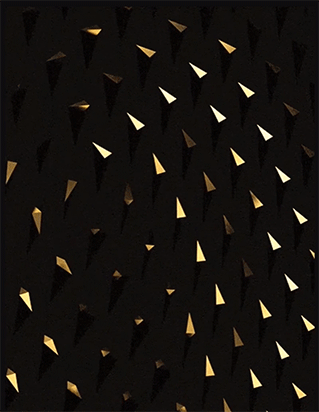Vernissage Insights: Spotlight on our top pavilion picks from the 60th Venice Biennale
Our team, Lidija Ristić, Brajan Vojinović, and Milica Grujić, has carefully selected 18 pavilions that resonated with us during our visit to the Vernissage — an opportunity made possible through the generous invitations from Serbian and Montenegrin officials, respectively. Each selection, born out of collective deliberation as well as individual insight, represents a unique facet of the Biennale’s extensive scope.
During our exploration, we identified several dominant themes that transcended this year’s focus on representing underrepresented groups. Elements such as water, performance, video, sound, and smell played crucial roles, each interestingly used to captivate and challenge the sensory experiences of the audience. Additionally, many pavilions featured rituals, spiritual, and religious imagery, enriching the visual narratives with depth and introspection. Another significant trend was the introduction of first-time exhibitors in established pavilions, finally infusing fresh perspectives and new energies.
Once again, we’ve observed a stark disparity in production budgets among countries participating in the Biennale, an issue that cannot be overlooked. This financial imbalance significantly affects the scale, technological sophistication, and overall visibility of exhibitions, effectively skewing the competitive landscape. We are committed to addressing this critical issue in our future discussions, dissecting how these economic discrepancies shape the cultural and artistic expressions presented at this globally recognized event.
This article marks the beginning of our quest to unravel the depths of artistic discourse presented at the Biennale. It serves not only as a guide to the highlights and hidden gems of the exhibition but also as an invitation to ponder the broader implications of these works within today’s globalized cultural and socio-political context. As we prepare to delve deeper into comprehensive analyses in the upcoming months, join us in reflecting on these initial takeaways, which are only a glimpse into the profound impact of the 60th Venice Biennale on the world of art and beyond. Here, we share our curated insights and a few honorable mentions, each a testament to the diversity and deep connectivity inherent in today’s global art scene.
Lidija’s top picks
Great Britain
John Akomfrah transforms the British Pavilion into an lyrical journey of audio visual richness that tackles the history and ongoing ramifications of English colonial policy across the globe. His intimate moving portraits humanize the almost unfathomable complexity of these centuries old legacies. Luscious colors, textures, mesmerizing soundscapes and skillfully-crafted abstract narratives entrance on every level. Akomfrah’s multi-screen art film installations layer on each other and intensify as the exhibition moves from the basement level of the building to the top floor. Here too, as with their neighbors at the German Pavilion, the main entrance is barricaded; signaling a departure from the status quo. Indeed this blocked-off passageway served as a stage for a live performance by a musical group from Akomfrah’s native Ghana during the pavilion’s opening ceremony. The artist and filmmaker’s practice has centered on the exploration of racial injustice, colonial legacies, diasporic identities, migration and climate change. His commission for the 60th Venice Biennale is a pitch-perfect response to this year’s theme: “Foreigners Everywhere”.
Akomfrah at Venice: A Multisensory Exploration of Diaspora and Change
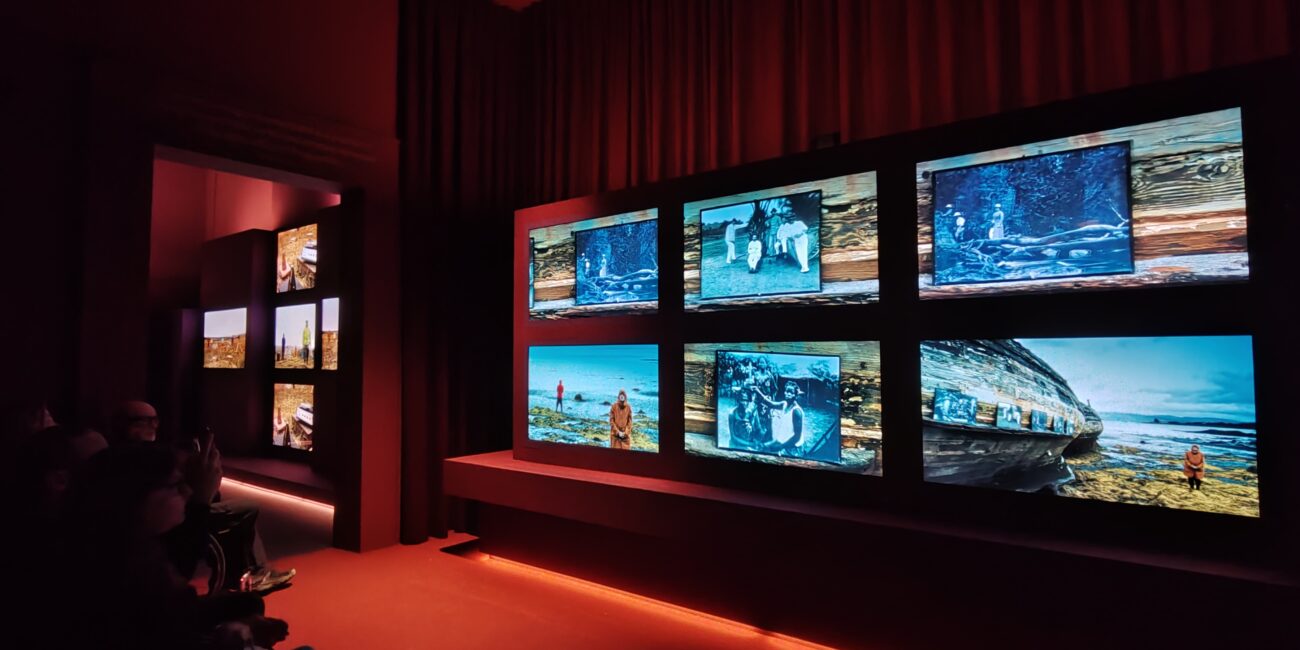
British Pavilion by Lidija Ristić
Malta
One of the few examples of true integration between art and technological advancement at the 60th Venice Biennale. Artist Matthew Attard uses state-of-the-art eye-tracking software as an extension of his drawing practice. Large LED TVs display digital video works reminiscent of hand-drafted cartography, astrological constellations, motion graphics, geo-mapping and even early cubist/modernist compositions. Attard’s world is one of precise digital semiotics in which the symbolic language has been developed to a sophisticated degree. But we, the viewers, can only partake as uninitiated spectators. Yet, the atmosphere is not unwelcoming. Simply, we have yet to decipher the specificity of its codex. In the dark passageway of the Maltese pavilion, human and machinic dynamics are under consideration. One possible conclusion made is that through global satellite technologies, humans are now able to make the entire surface of the earth our canvas.
Matthew Attard merges art and technology at the Malta Pavilion, using eye-tracking software to create digital compositions that evoke cartography and cubism on large LED displays.
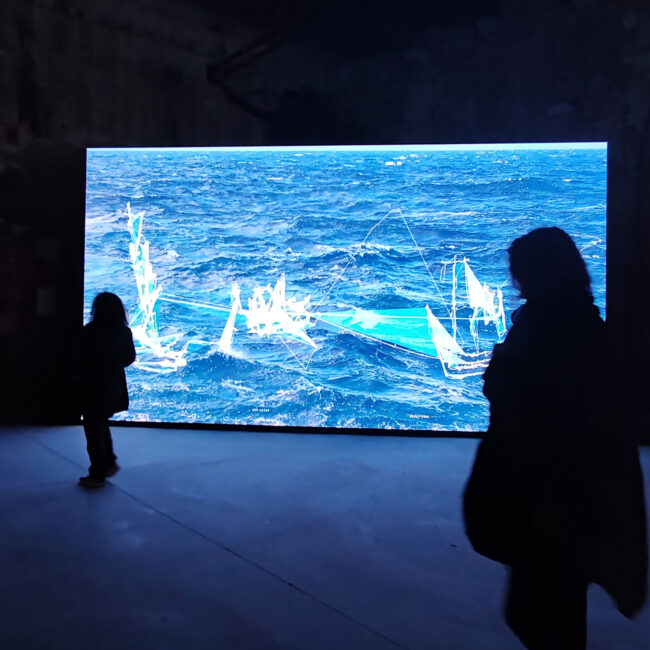
Maltese Pavilion by Lidija Ristić
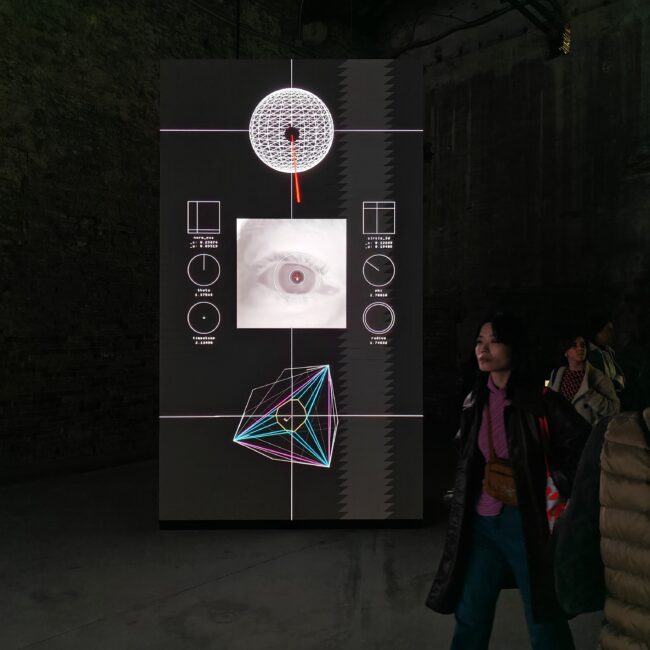
Maltese Pavilion by Milica Grujić
Uzbekistan
Aziza Kadyri elegantly employs her background in set and costume design to head up Uzbekistan’s representation at this year’s Venice Biennale. Kadyri shares this metaphorical and literal stage with the Tashkent-based artist collective Qizlar. This interdisciplinary installation spotlights themes of cultural code-switching, hybrid/diasporic identities and long honored traditions transmuted via emerging technology. Kadyri and Qizlar are one of the few, if maybe the only, to utilize generative Ai at the 60th Venice Biennale. They use the software’s inherent western biases to manipulate traditional Uzbek motifs thus turning machine learning technology into a tool that speaks to the erasure of -predominantly female- narratives of the Global South. Young diasporic artists like Kadyri (an Uzbek native raised in London), intrinsically embody the Biennale’s overarching concept- “Foreigners Everywhere”. This fact may account for the intimate and authentic expression evident in this presentation. The Uzbekistan pavilion asks: how is belonging performed and who is it that codifies what that belonging looks like?
The Uzbek Pavilion at the Venice Biennale employs generative AI to explore and question concepts of identity and belonging.
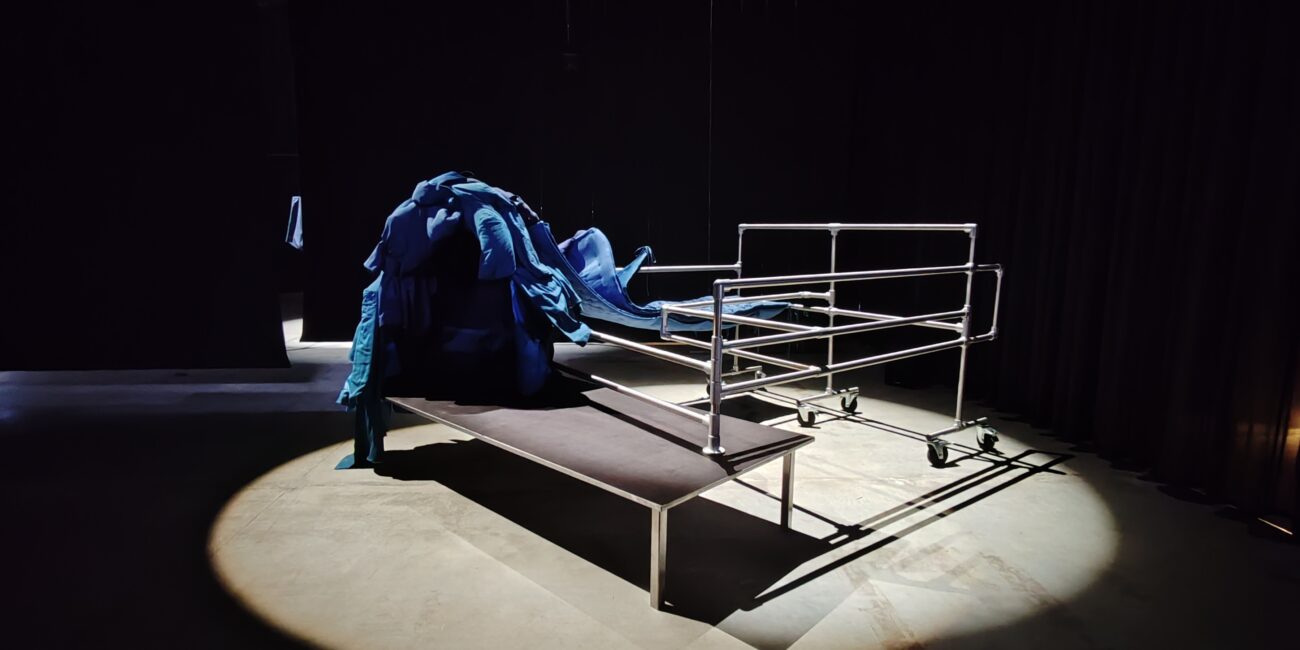
Uzbek Pavilion by Lidija Ristić
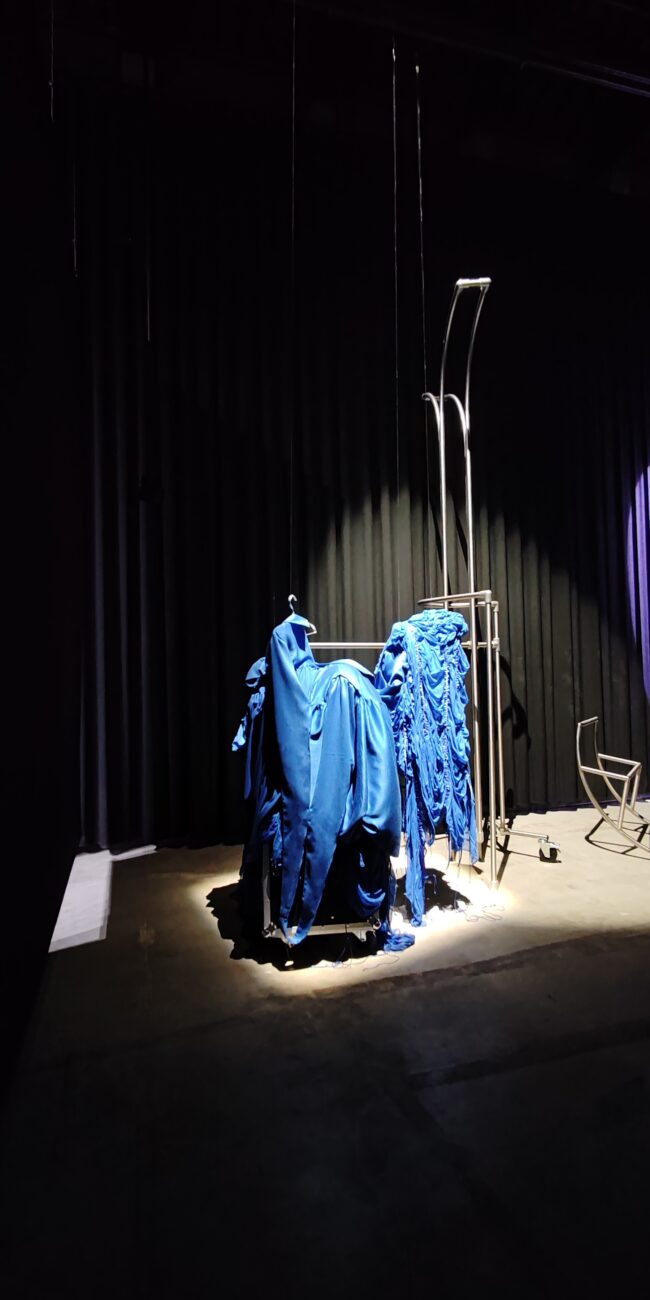
Uzbek Pavilion by Lidija Ristić

Uzbek Pavilion by Jovan Matić
Czech Republic
Macabre? Yes. Playful? Yes. Even a little kinky? Yes. Addressing the ugly underbelly of Europe’s long tradition of cross-continental wildlife exploitation in the name of entertainment and profit? Yes. Awash in a sea of safe and sure-fire showcases, the Czech representation at this year’s Biennale is a breath of fresh, much-needed, risk-taking. From the moment you are invited to enter a larger-than-life, plush tunnel of giraffe entrails to the appearance of gimp-mask-esq costumes hanging adjacent to children’s coloring book stations- this pavilion is an experience unlike any other; especially when contrasted with the tame landscape mural on the building’s exterior presented by the Slovak division of the pavilion. Check it out and let us know if you think their risk-taking paid off.
From giraffe tunnels to gimp masks: Czech pavilion takes a walk on the wild side.
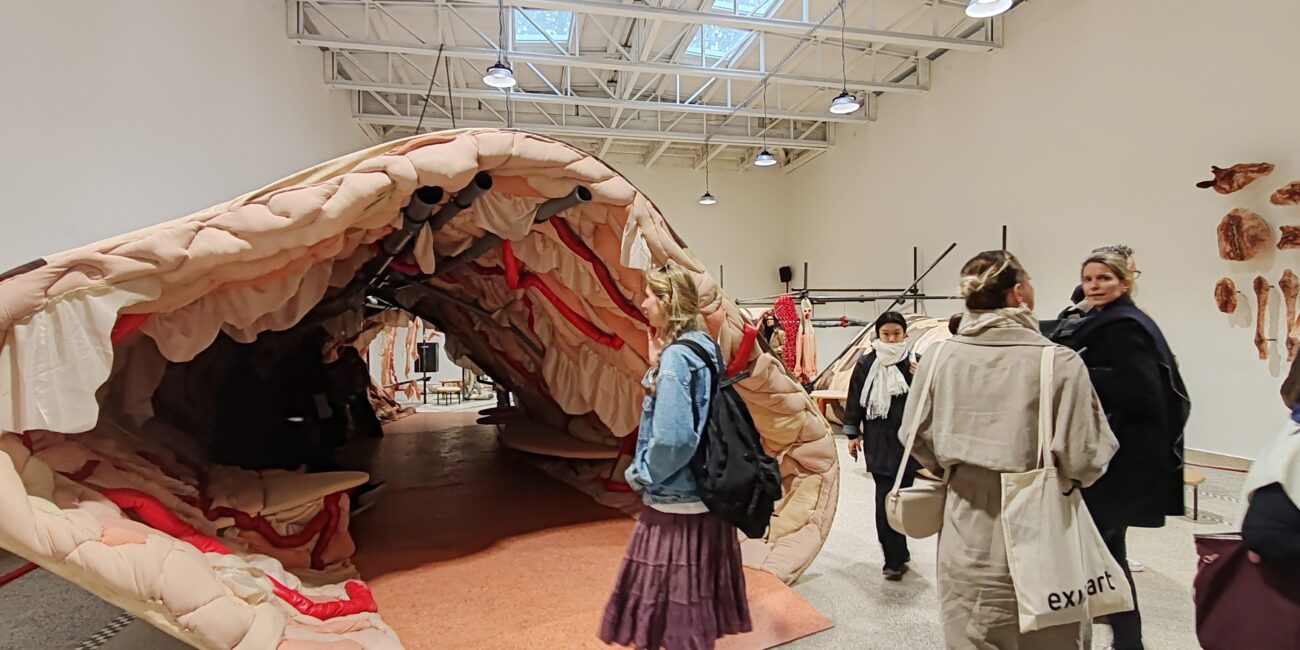
Czech Pavilion by Lidija Ristić
Germany
An interdisciplinary tour de force and a preeminent example of contemporary exhibition craft. Artists Ersan Mondtag and Yael Bartana know how to set up and deliver on an anticipation-packed journey through light, sound, video and large-scale, detail-driven installations. Whatsmore, they know how to round it all off with a major bang via an immersive ensemble performance that takes place within a richly articulated, multi-level stage. Bartana’s hyper-polished sci-fi mythological/kabbalistic universe is sharply contrasted by Mondtag’s Herzogian working-class ghost world dystopia. The stark dichotomy between their equally dexterously executed realms proves to be the ultimate symbol of our current polarized global reality. We spent four hours waiting to view the pavilion’s installation and bear witness to the live performance. It was worth every vigilant moment and every sore muscle. If you crave a transformative experience, the German Pavilion at this year’s Venice Biennale is a must-not-miss!
A journey through Bartana’s Sci-Fi universe and Mondtag’s ghost world.
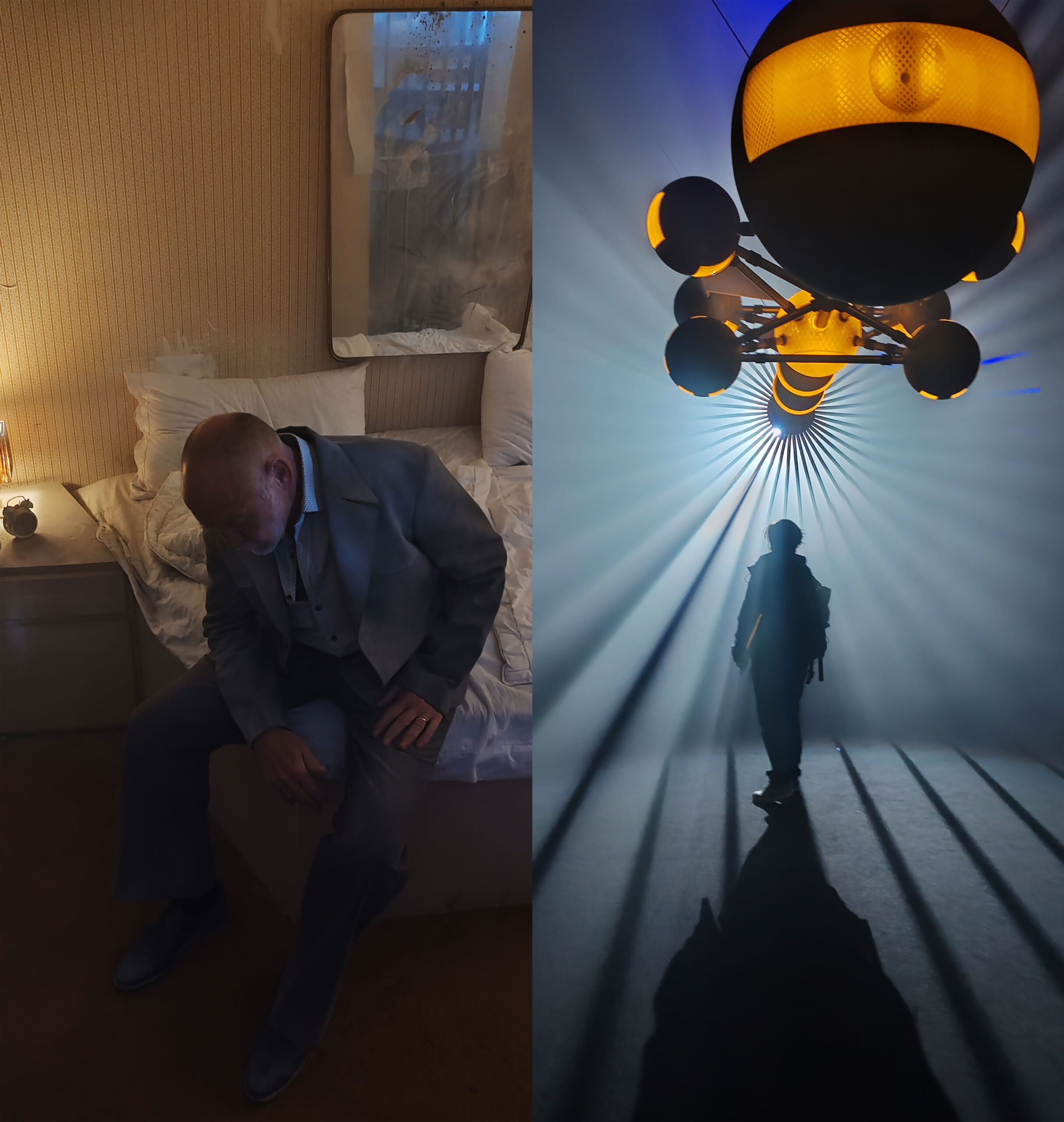
German Pavilion by Lidija Ristić
United States
Do not go see this exceptional showcase of Jeffrey Gibson’s simply to say you witnessed the first indigenous Biennale representative for the United States. Go see it to be immersed by sophisticated color play set within superlative exhibition design. Gibson is best known for his beaded figurative sculpture works. However, it is his mixed media paintings that truly shine here. The masterfully interlacing layers of both 2d techniques and beaded 3d applique, double down on the overall hypnotic, trompe-l’œil effects that distinguish the interior and exterior of this year’s US pavilion. Gibson’s artistry is both visually arresting and acts as a symbolic seesaw that dances between overt calls to activism and formal aesthetic exploration on a virtuosic level. This “medium as message” approach is generously exemplified by the presence of the three plinths outside the pavilion where Gibson has invited performers to share his prestigious appointment on the international stage.
Gibson’s artistry is both visually arresting and acts as a symbolic seesaw that dances between overt calls to activism and formal aesthetic exploration on a virtuosic level.

USA Pavilion by Lidija Ristić

USA Pavilion by Lidija Ristić
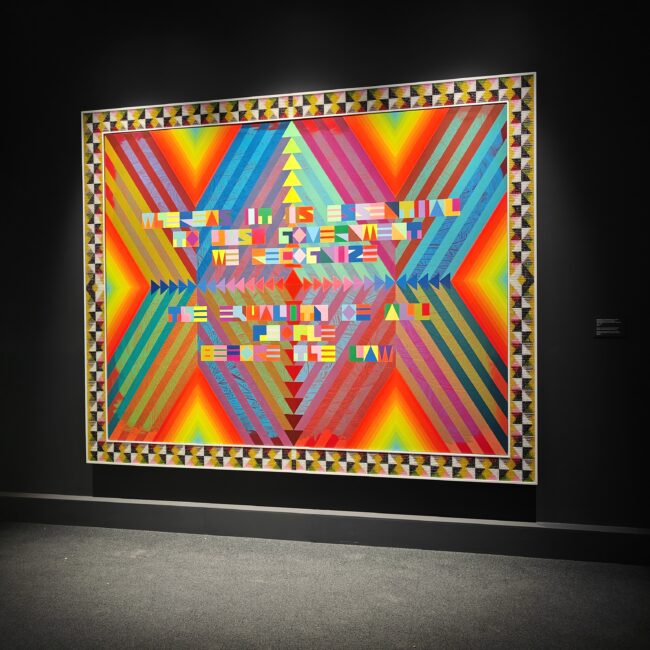
USA Pavilion by Milica Grujić
Milica’s top picks
Nigeria
The Nigerian Pavilion themed “Nigeria Imaginary,” curated by Aindrea Emelife, opens with Precious Okoyomon’s sound installation that broadcasts an immense array of confessions from Nigerian artists, capturing the community’s dreams and realities. It sets a reflective tone for the exhibition, which explores Nigeria’s complex socio-political landscape. Ndidi Dike’s work delves into the October 8th 2020 End Special Anti-Robbery Squad (SARS) uprising, highlighting the youth’s use of digital media to transcend ethnic divisions and push for broad social reforms. The pavilion also features Yinka Shonibare’s sculptures reflecting on Benin’s looted art, while Fatimah Tuggar employs augmented reality, AI and animatronics to look at the erosion of Hausa architecture, and Onyeka Igwe’s films on colonial legacies. Abraham Oghobase and Toyin Ojih Odutola further explore Nigeria’s colonial past and post-independence creativity. This diversified collection provokes conversation on Nigeria’s identity, supported by Qatar Museums and other significant patrons, emphasizing a forward-looking narrative through historical and contemporary lenses.
Nigerian artists boldly confront colonial legacies and champion cultural preservation, delivering one of the Biennale’s most acclaimed presentations, evident in the bustling activity at their pavilion during the preview.
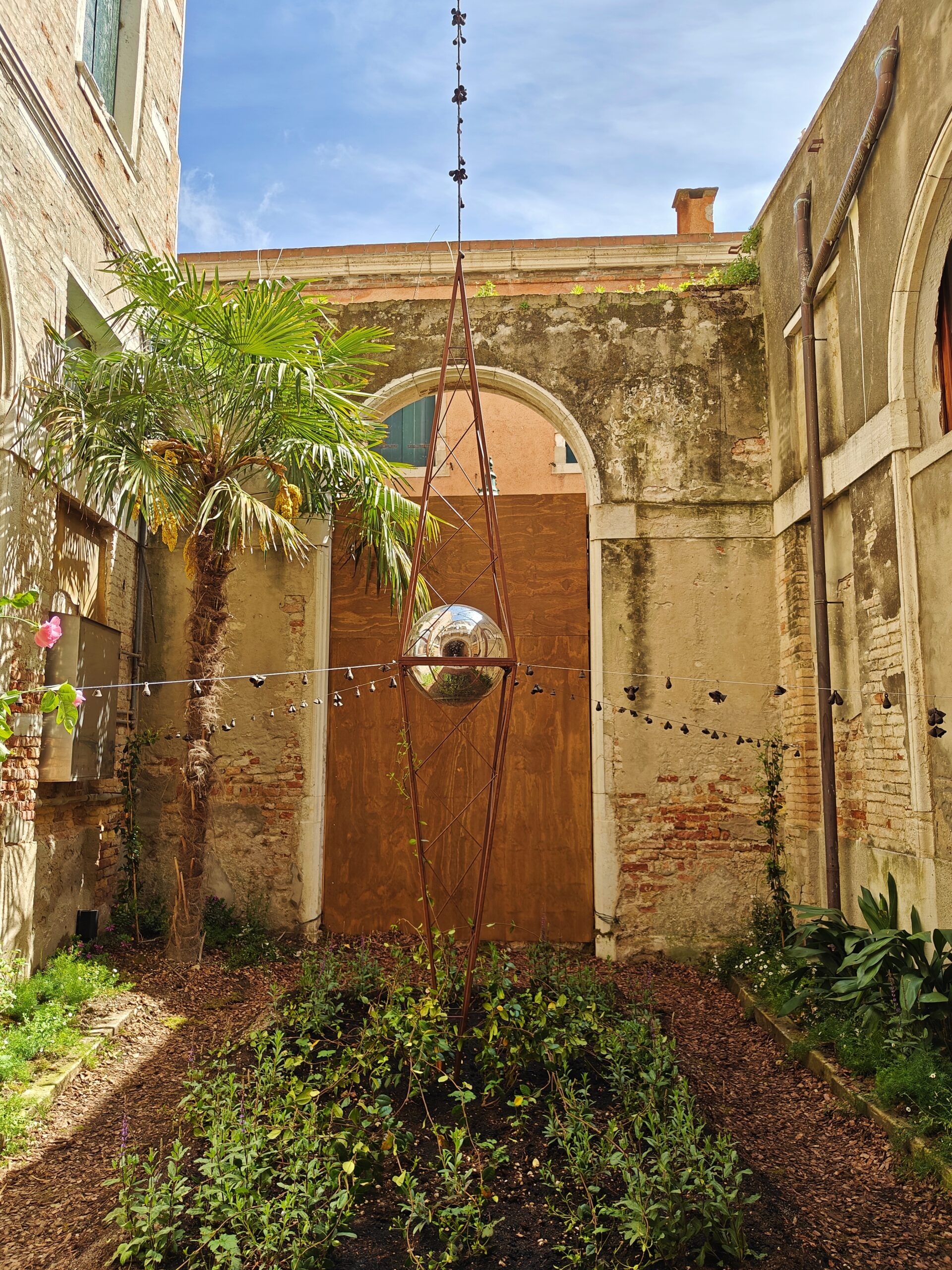
Nigerian Pavilion by Milica Grujić
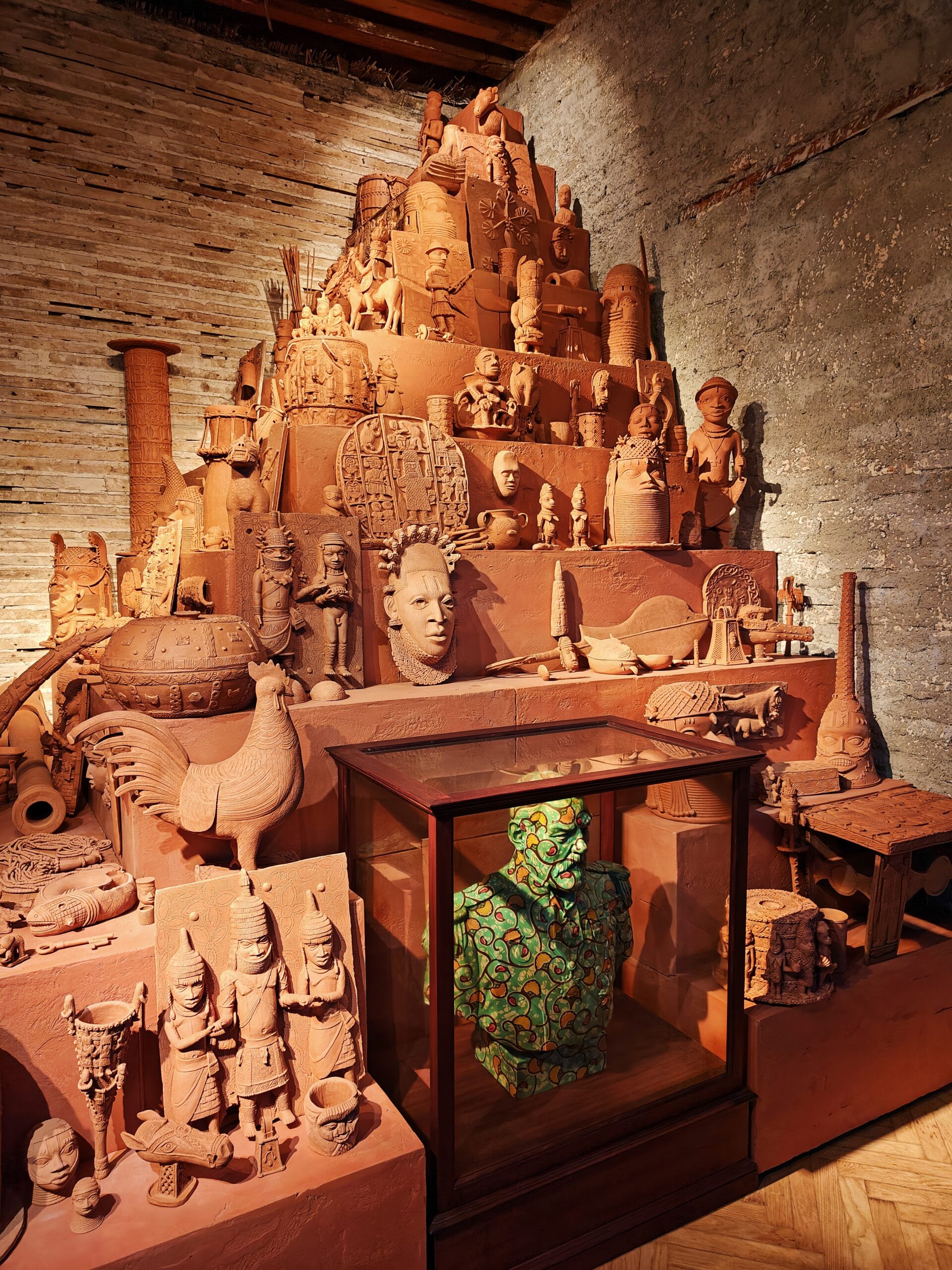
Nigerian Pavilion by Milica Grujić
Australia
Archie Moore’s award-winning exhibition at the Australian Pavilion, titled “kith and kin,” powerfully explores deep familial histories and broader socio-political themes reflecting the First Nations experience in Australia. His work aims to highlight the enduring impacts of Australia’s colonial past on its Indigenous communities, weaving personal narratives with broader historical contexts. The centerpiece, “Inert State,” featuring bureaucratic documents floating in water, powerfully reflects systemic challenges faced by Indigenous Australians, like poor access to health, education, and housing. These documents symbolize the stagnation in addressing critical issues such as Indigenous incarceration, which remains among the highest globally. The installation invites the audience to see their own reflections in the water, merging personal and collective experiences with the submerged texts. Moore also incorporates elements of Aboriginal art forms beyond the stereotypical Dendroglyphs—an engraving tradition of the Kamilaroi people—to explore themes of identity and belonging, thereby challenging and expanding viewers’ understanding of Aboriginal art.
While some critics have described the exhibition as boring, weak, predictable, and bleak, I found it to be dark, personal, and moving. It seems necessary to be constantly reminded that everyone’s story is different and deserves to be heard. Moore’s approach to addressing these themes in his art is not just a recount of historical grievances but a compelling invitation to engage and reflect on these ongoing challenges. His use of materials and symbols in “Inert State” enriches the narrative, making it not only a testament to suffering but also a call to action and empathy.
Archie Moore’s work explores deep familial histories and broader socio-political themes reflecting the First Nations experience in Australia.
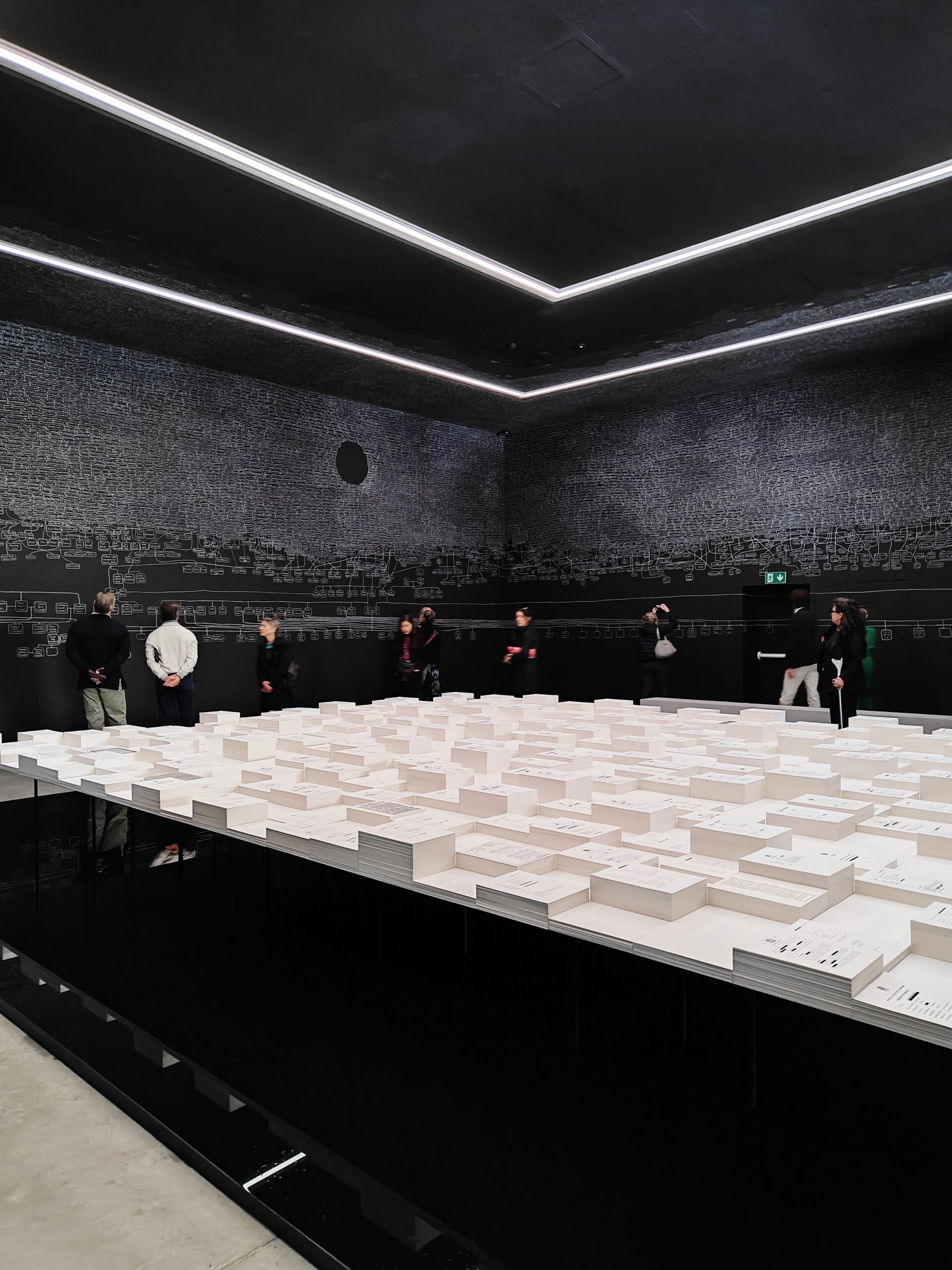
Australian Pavilion by Milica Grujić
Spain
I know what you’re thinking. Paintings? Groundbreaking! But I strongly advise you to reconsider skipping the Spanish Pavilion. Firstly, “Pinacoteca Migrante” is an experience. Beautifully designed, dark-colored spaces adorned with gold inscriptions, transporting viewers to another time when empires reigned supreme in all their colonial glory. Like entering into a National Museum of sorts. The collection of beautifully executed paintings looks like looted treasures from lands where people were enslaved, their culture robbed to allow the Western narrative to flourish and condemn the memory of anything “primitive” and indigenous.
By integrating ecofeminist perspectives and modifying historical illustrations, Gamarra’s work for this year’s Biennale confronts silenced cultures and challenges the monolithic narratives of Spanish history. It promotes a discussion between the past and present implications of colonial actions. This approach not only critiques but also contextualizes the lingering impacts of colonialism in a contemporary setting. And it is just perfect. Funny how we’ve made a full circle from being utterly bored with paintings to finding them a pleasant surprise.
“Migrant Art Gallery,” curated by Agustín Pérez Rubio and featuring the work of Peruvian artist Sandra Gamarra, re-examines Spain’s colonial past through a decolonial lens.
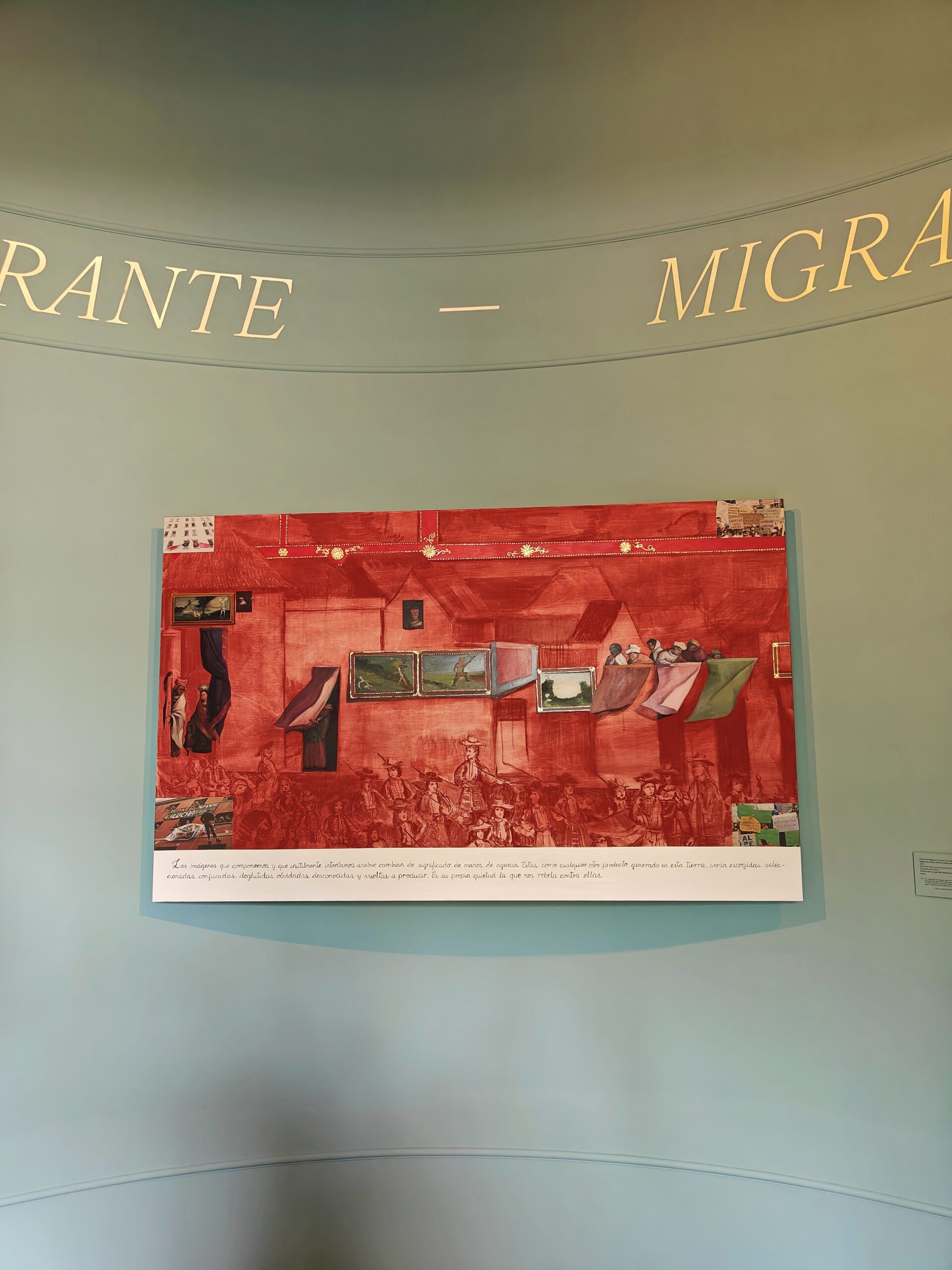
Spanish Pavilion by Milica Grujić
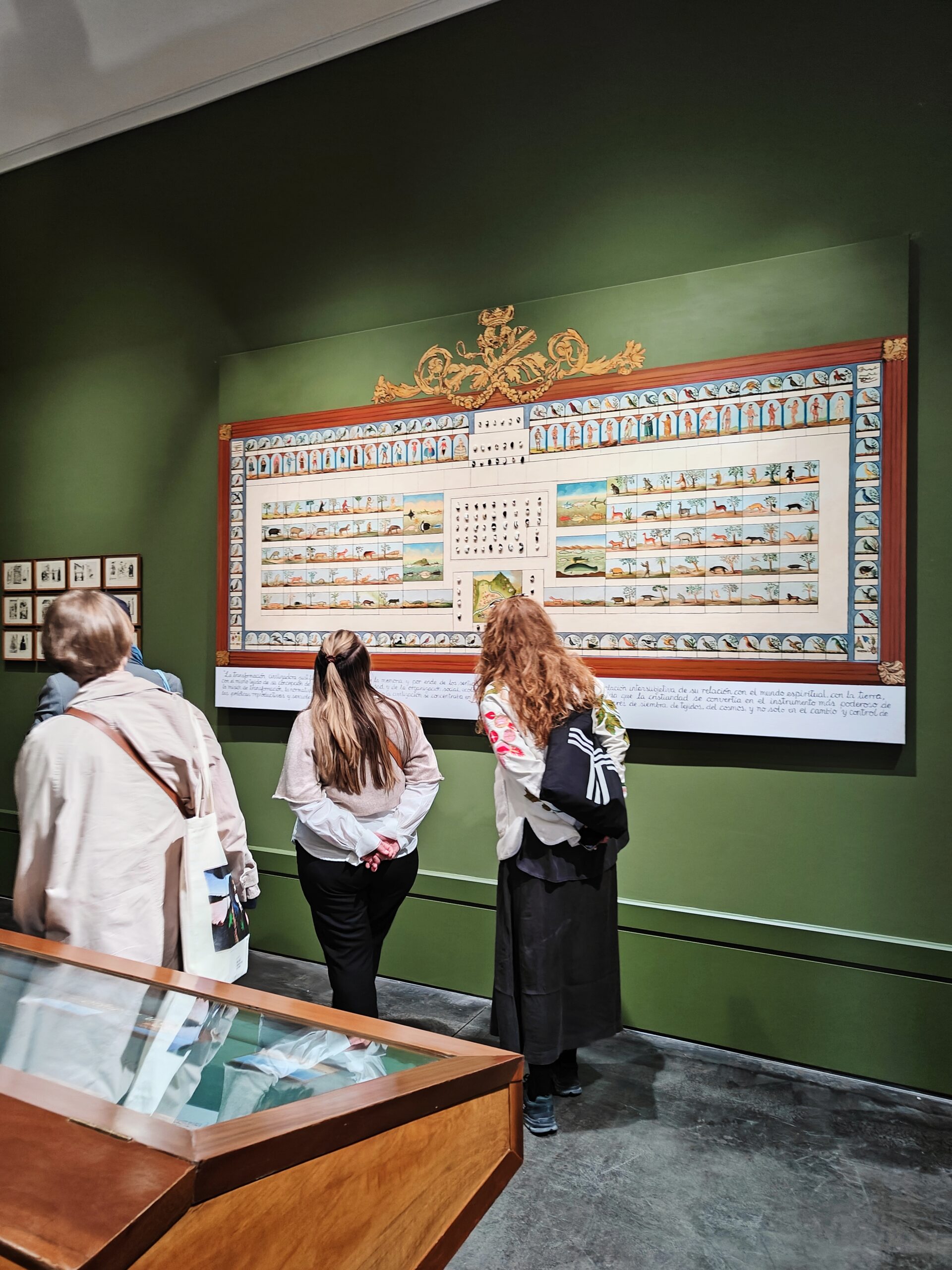
Spanish Pavilion by Milica Grujić
Poland
The Polish Pavilion’s switch from “Polish Practice in Tragedy. Between Germany and Russia” to “Repeat after Me” by the Ukrainian collective Open Group has sparked significant controversy. This change, influenced by revised competition procedures and community feedback, substituted a local narrative with that of non-Polish artists. While supporting Ukrainian voices is commendable, especially given their current hardships, this decision raises questions about fairness and the sidelining of Polish artists.
“Repeat after Me” including Yuriy Biley, Pavlo Kovach, and Anton Varga and curated by Marta Czyż, focuses on themes of memory and expression. The exhibition features two large, interactive displays and the array of microphones designed to engage and involve the audience, reflecting the dynamic and evolving nature of contemporary art presentations at major international events.
Nonetheless, it was powerful. I repeated the ugly war noises with others in the Pavilion and was reminded of my own childhood in a bombarded country. I felt retraumatized, and it made an impact. Overall, it was a great presentation.
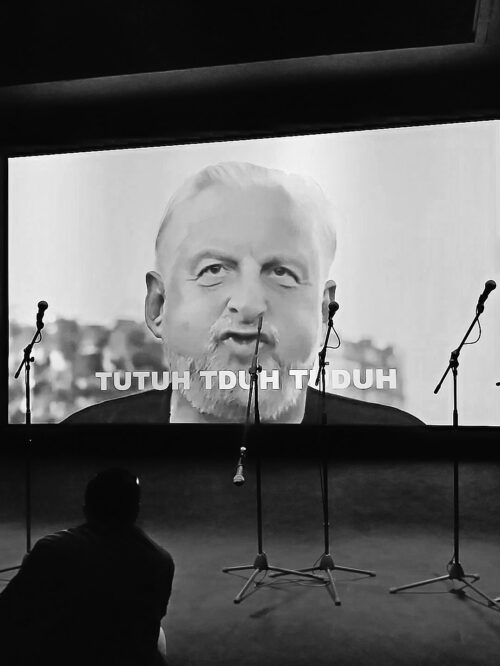
Polish Pavilion by Milica Grujić
The Polish pavilion’s unexpected shift sparks artistic dialogue while “‘Repeat after Me’ by the Open Group stands as a poignant reflection on the power of memory and voice, compelling viewers to engage with the layers of collective and personal histories.
Portugal
I know what you’re thinking (again). A garden inside a gallery? Hardly a novel idea, yet there’s something undeniably Portuguese about this gesture. It harkens back to the lush, blooming landscapes of Sintra, where natural beauty and human history intertwine—and tourists gather by the busloads to wander uphill, exhausted.
The “Greenhouse” at the Portuguese Pavilion, led by Mónica de Miranda, Sónia Vaz Borges, and Vânia Gala, crafts this garden not just as a symbol of life and resistance but also as a clever nod to the often overlooked narrative of ecological migration. In my eyes, the trees populating this ‘Creole garden’ are like foreigners themselves, brought into Portugal from various corners of the earth, mirroring the country’s colonial past where everything exotic was coveted, transported, and replanted. Thus, what appears as a simple act of gardening unfolds into a sophisticated commentary on beauty derived from displacement and survival—an elegant, yet gut-wrenching, reflection on the dire consequences of historical conquests and cultural amalgamation. This installation, while offering a serene respite, subtly challenges us to see beyond the aesthetic to grasp the complex narratives of control and adaptation, much like the diverse ecosystems of Portugal itself.
“Greenhouse” invites visitors to engage in a living archive of cultural dialogue and reflection. It challenges conventional identities and histories, fostering a community-centric space of learning and creative interaction.
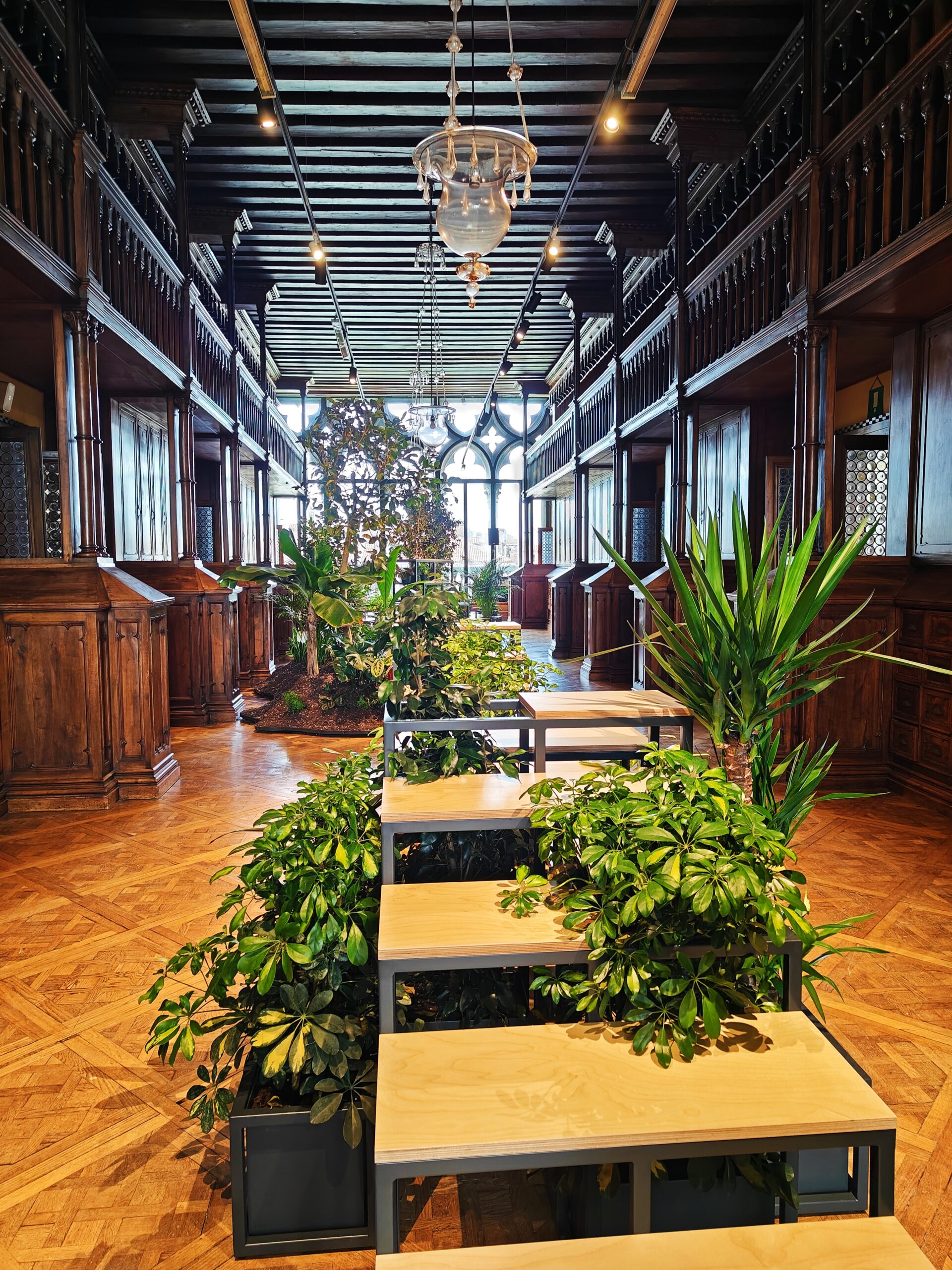
Portuguese Pavilion by Milica Grujić
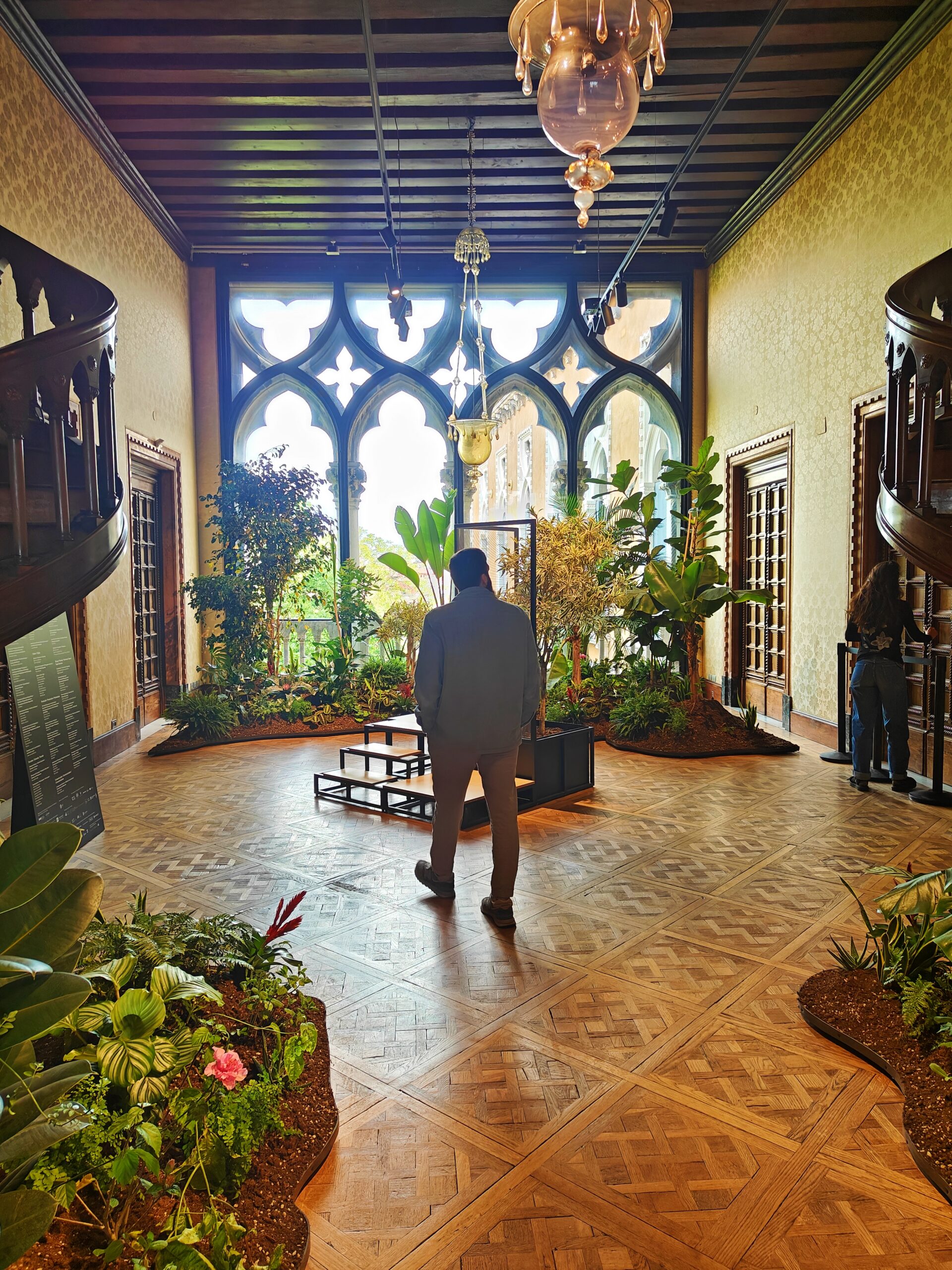
Portuguese Pavilion by Milica Grujić
Hungary
The Hungarian Pavilion and the “Techno Zen” exhibition, curated by Róna Kopeczky and organized by the Ludwig Museum, truly left me in awe. Artist Márton Nemes transformed the space into a sensory haven, masterfully blending the raw, aggressive energy of techno culture with the wise tranquility of Zen. The use of advanced industrial materials, cutting-edge technology, and scrupulous manipulation of light and sound create a multisensory experience that transcends traditional art forms. The result is not just an exhibition but an experience of pure, unadulterated ecstasy.
This Pavilion captivated me with its simplicity and focus on aesthetic experience—art for art’s sake that unexpectedly evoked a literal euphoria. The strategic use of space, vibrant colors, and the absence of heavy, dark narratives transported me to a realm of beauty and contemplation. It reminded me of one undeniable purpose of art, often overlooked and forgotten these days: to help us find inner peace. “Techno Zen” did exactly that, providing a sanctuary from the digital chaos of our times and the prevailing doom and gloom of other exhibitions, to be completely honest.
While I might have wished for a stronger connection to the broader themes of the Biennale, ultimately, that didn’t matter. The exhibition delivered something spectacular that didn’t need elaborate explanations to be profoundly impactful.
* More on “Techno Zen” in the upcoming months.
Marton Nemes captures an electrifying intersection of cultures, where the chaotic beats of techno are harmoniously aligned with the profound calm of Zen.
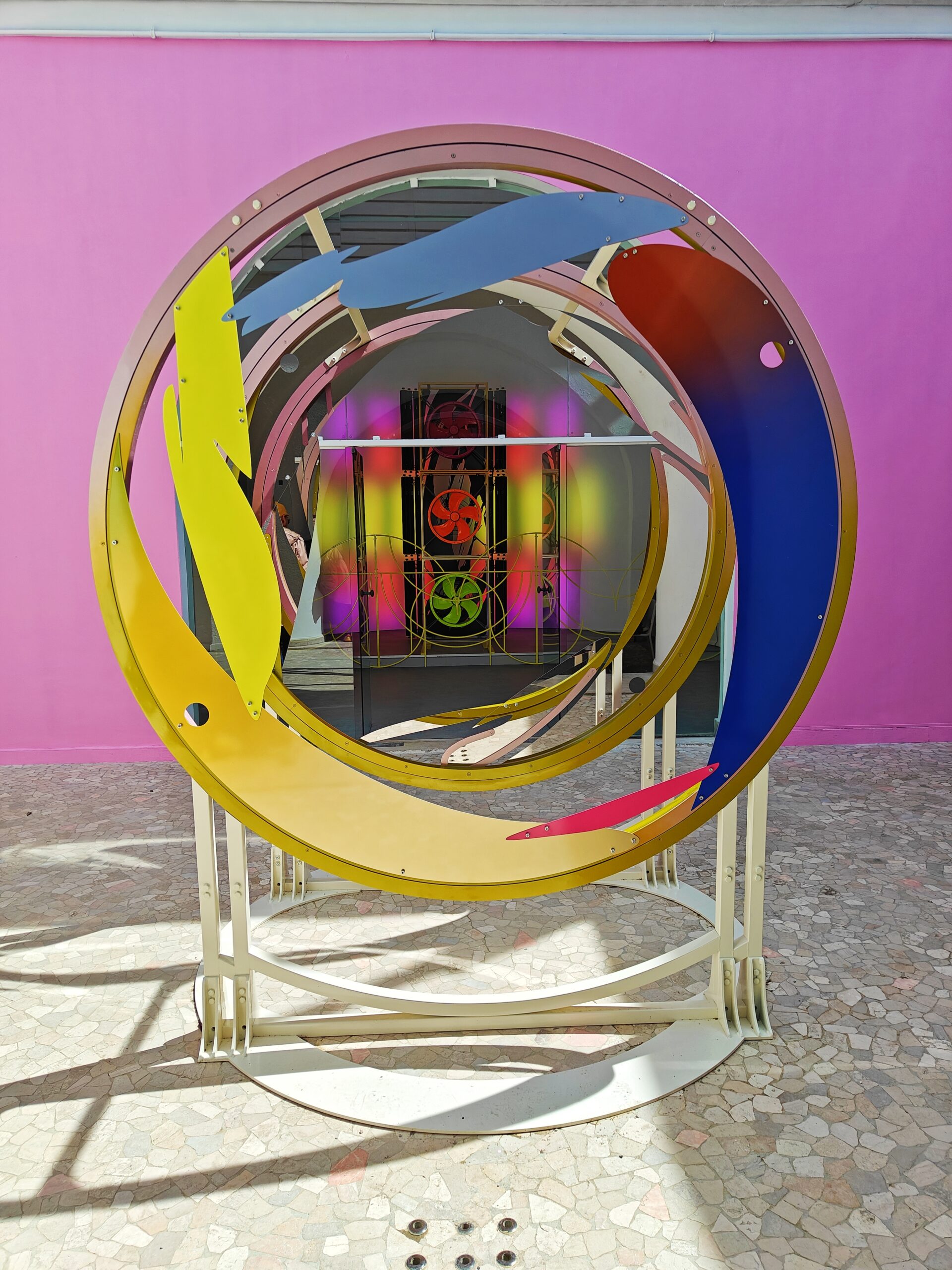
Hungarian Pavilion by Milica Grujić
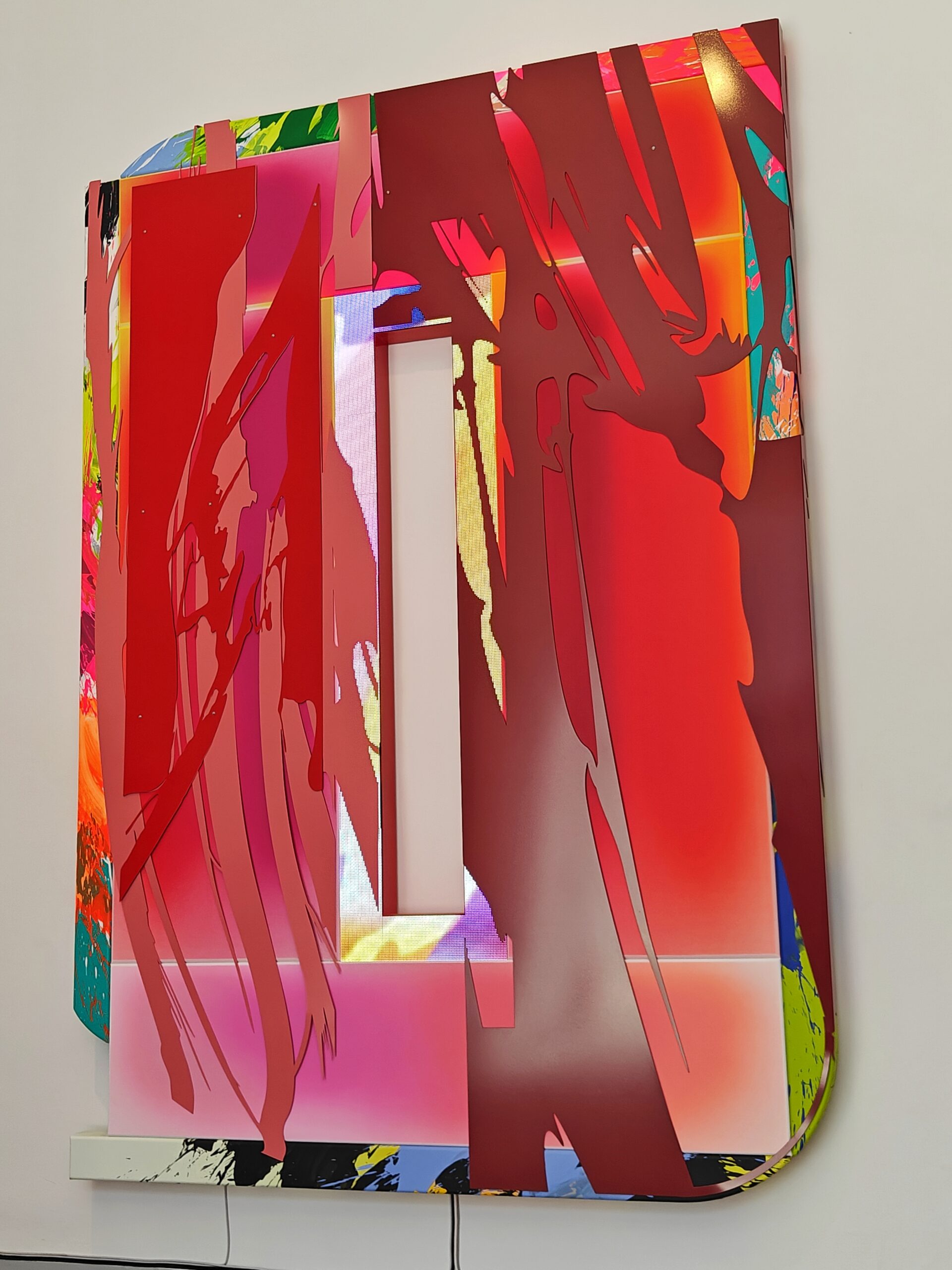
Hungarian Pavilion by Milica Grujić
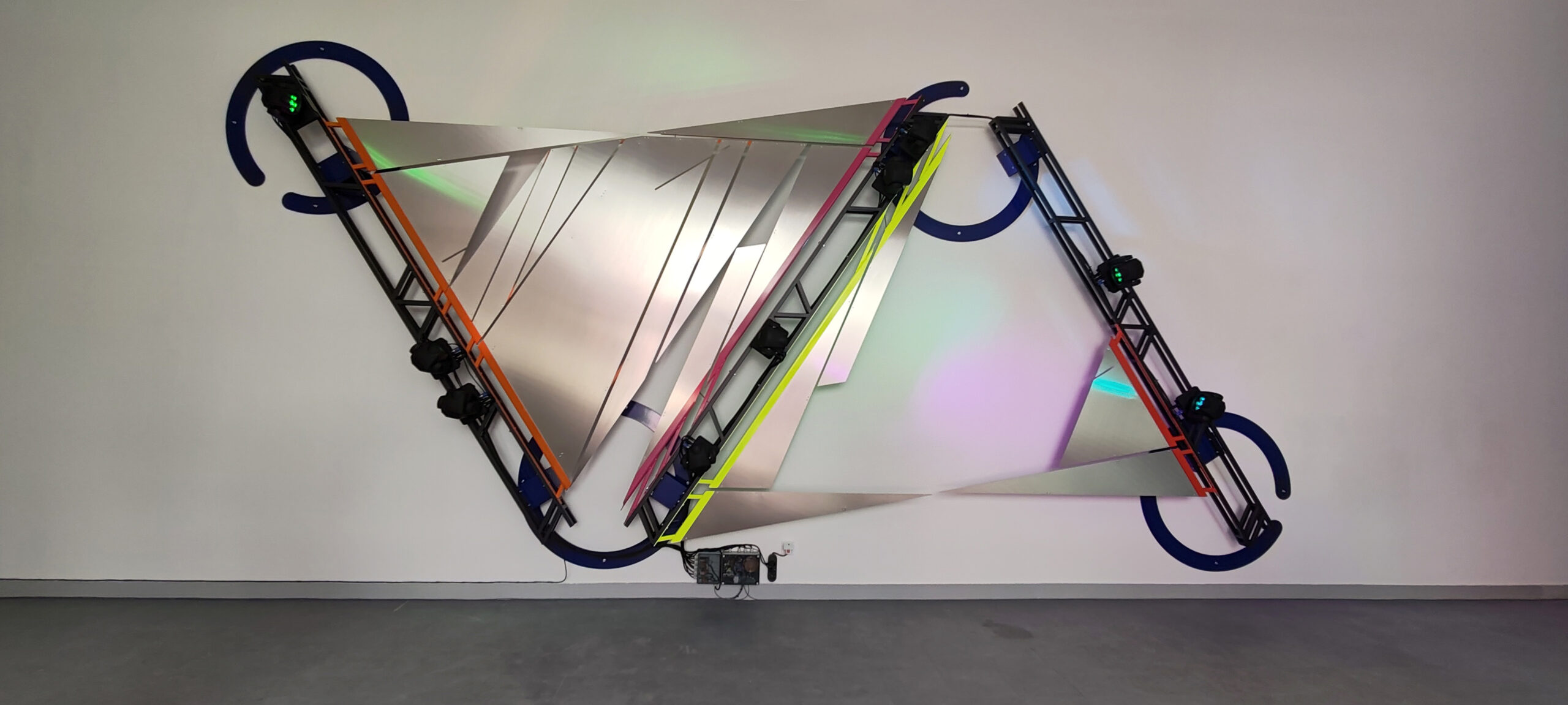
Hungarian Pavilion by Lidija Ristić
Brajan’s top picks
Greece
Xirómero/Dryland is a collaborative audio-visual installation merging research, performance, and video art, created by a diverse team of artists and theorists. Focused on water, it delves into the political potency of sound, technology’s impact on rural landscapes, and cultural richness. Inspired by provincial fairs in Central Greece, it explores gender dynamics and the blurred line between performance and reality. The project, named after the Xirómero region, taps into local traditions, particularly in its Greek pavilion rendition, where the community’s outdoor gatherings are transposed indoors. Through this, it connects the specificity of regional customs to broader global shifts in aesthetics and traditions. Xirómero/Dryland serves as a lens through which to examine evolving rural life and celebration amid changing cultural landscapes. It raises questions about tradition, change, and the political undercurrents shaping these processes, inviting viewers to ponder the intersection of local and global narratives.
Inspired by provincial fairs in Central Greece, it explores gender dynamics and the blurred line between performance and reality.
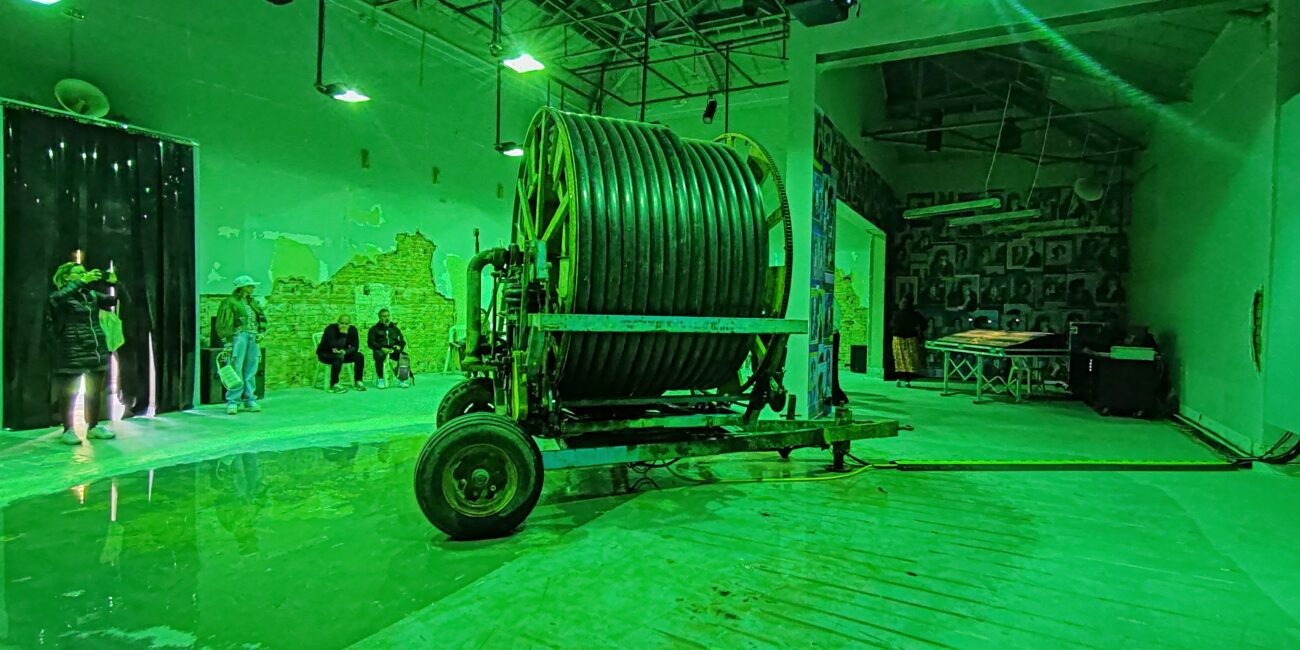
Greek Pavilion by Lidija Ristić
Switzerland
The Swiss Pavilion, curated by Swiss-Brazilian artist Guerreiro do Divino Amor and titled “Super Superior Civilizations” subverts the traditional notion of national representation through a playful exploration of cultural identity. Embracing the spirit of the Biennale’s origins, Amor’s work challenges viewers to reexamine their biases and preconceptions about national pride and stereotypes. Through his imaginative lens, he invites us to confront chauvinism with laughter and benevolence, offering a much-needed antidote to the polarizing political climate of our times. Divided into two parts, “Miracle of Helvetia” and “Roma Talismano,” the exhibition unveils chapters of Amor’s ambitious “Superfictional World Atlas” saga, a project two decades in the making. With allegorical depth and boundless creativity, his work satirizes power dynamics in media, finance, and religion, encouraging reflection on the ways these institutions shape collective imagination. In a world fraught with division, Amor’s pavilion serves as a beacon of humor and critical inquiry.
Embracing the spirit of the Biennale’s origins, Amor’s work challenges viewers to reexamine their biases and preconceptions about national pride and stereotypes.
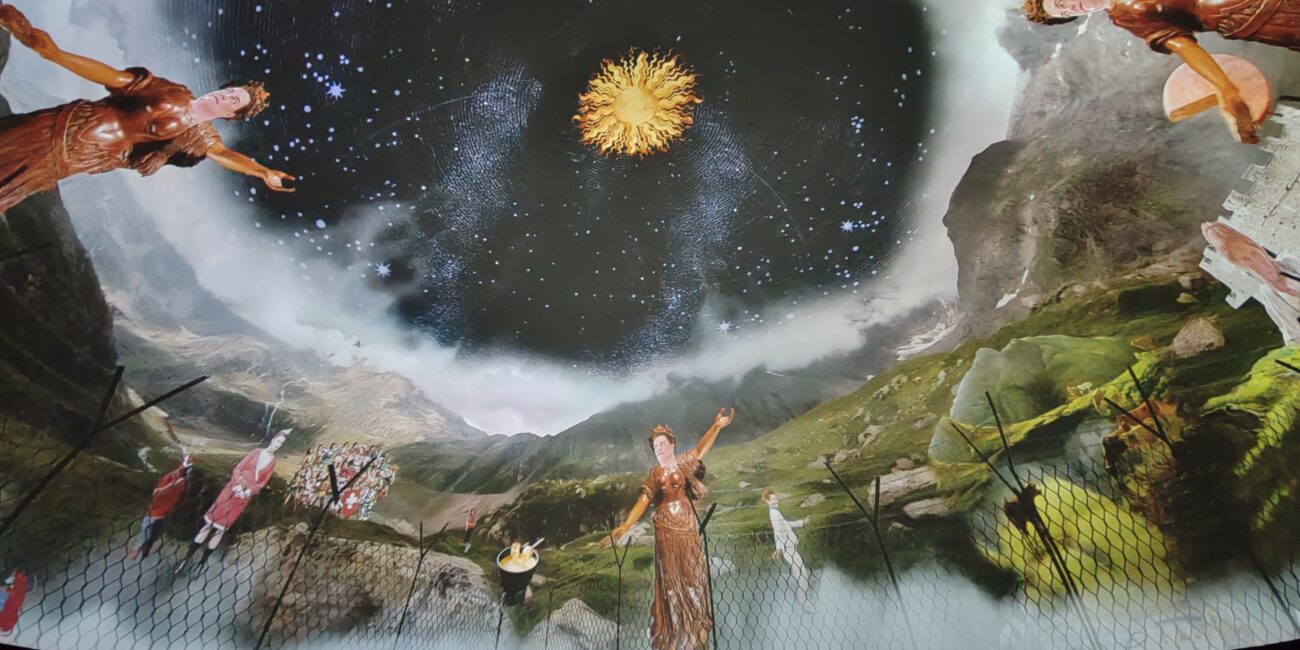
Swiss Pavilion by Lidija Ristić

Swiss Pavilion by Lidija Ristić
Serbia
The exhibition title, “Exposition coloniale,” evokes the enduring legacy of colonialism, a theme central to Denić’s artistic inquiry. Drawing from his background in theater, Denić skillfully navigates complex societal issues, weaving together narratives that resonate with contemporary relevance. Through intricate spatial constructions, he confronts viewers with the lingering effects of usurpation and division, prompting introspection on power dynamics and consumerism. Denić’s work serves as a poignant reflection of our society’s anxieties and lost intimacies, inviting audiences to reconsider their understanding of cultural hegemony and societal norms. Symbolic inversions within the exhibition challenge viewers to confront uncomfortable truths about the ongoing impact of colonial legacies on human values and principles. As a foreign artist permanently displaced to German-speaking regions, Denić’s perspective adds depth to his exploration of displacement and identity in a globalized world.
Denić’s work serves as a poignant reflection of our society’s anxieties and lost intimacies, inviting audiences to reconsider their understanding of cultural hegemony and societal norms.

Serbian Pavilion by Milica Grujić

Serbian Pavilion by Milica Grujić
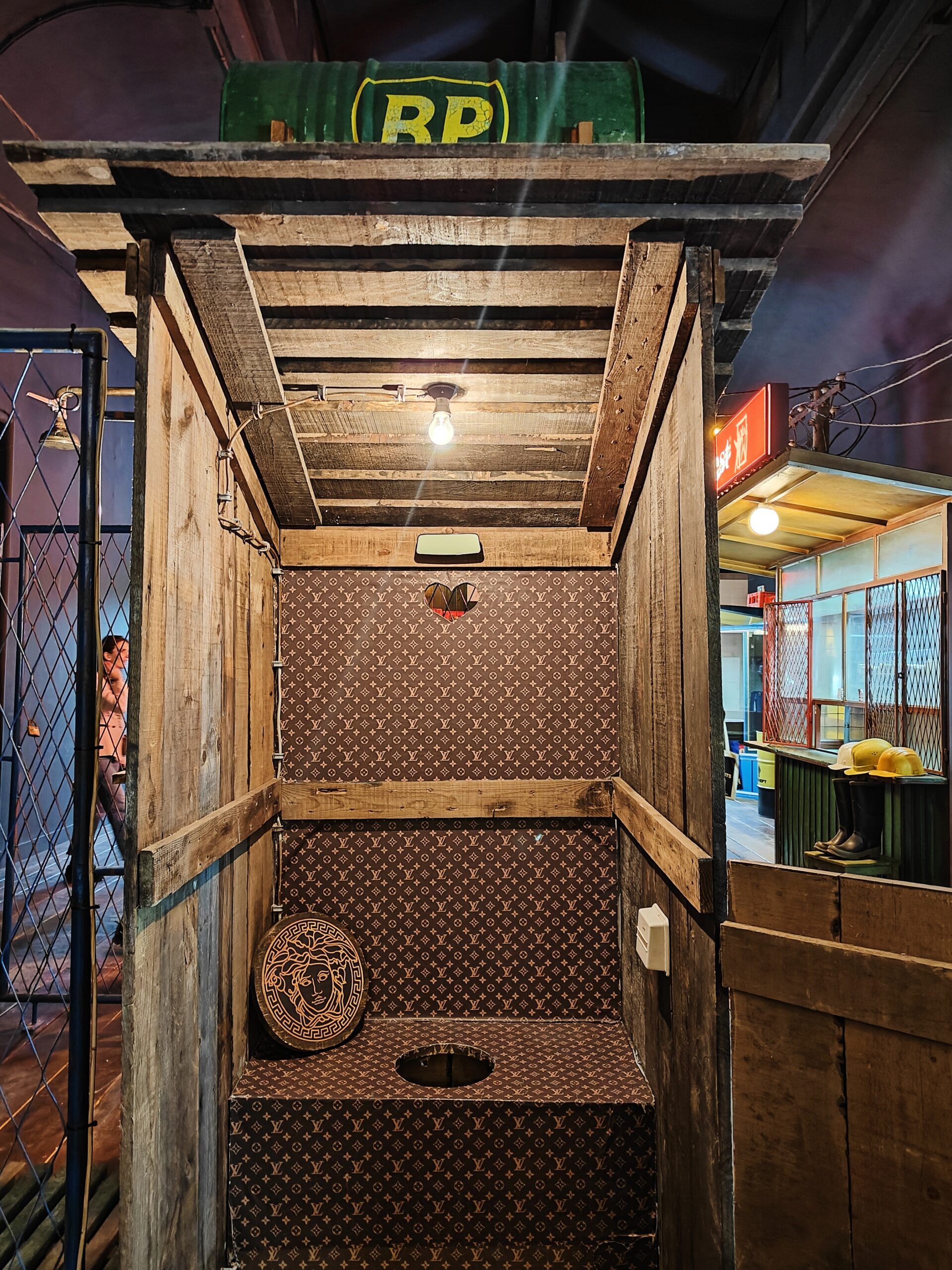
Serbian Pavilion by Milica Grujić

Serbian Pavilion by Milica Grujić
Egypt
Deeply immersed in the cultural heritage of the Arab world, Wael Shawky’s work unfolds as a meticulous examination of historical narratives, highlighting the subjective nature of historical interpretation. “Drama 1882,” commissioned for the Egyptian Pavilion, delves into the events surrounding Egypt’s Urabi revolution of 1879–1882. Through an epic musical film, he reimagines the tumultuous sequence of events, from a café brawl to the British bombardment of Alexandria, shedding new light on a critical period in Egyptian history. Shawky’s work serves as a compelling testament to the fluidity and complexity of historical memory.
From café brawls to British bombs, Shawky’s ‘Drama 1882’ serves history with a side of epic drama.

Egyptian Pavilion by Lidija Ristić
Italy
The focal point of the Italian Pavilion is a monumental installation and sound piece by artist Massimo Bartolini, titled “Due qui / To Hear”. Bartolini’s work intertwines with the pavilion’s spaces, leading viewers on a journey through alternating full and empty areas, movement, and repose, offering unexpected encounters with sound-based and performative elements. The title itself, a play on words between “two here” and “to hear” in Italian, hints at the act of listening as a directed action towards others. Throughout his three-decade career, Bartolini has intertwined meeting, listening, and relationships, shaping Due qui / To Hear as both a physical and metaphorical experience—an invitation to attentiveness and openness to others. In dialogue with the theme of the 60th Venice Biennale, Bartolini’s project reframes the concept, suggesting that embracing oneself is essential to avoiding foreignness. “Listening to the self” becomes pivotal in understanding one’s place within society and relationships.
Bartolini’s work intertwines with the pavilion’s spaces, leading viewers on a journey through alternating full and empty areas, movement, and repose, offering unexpected encounters with sound-based and performative elements.
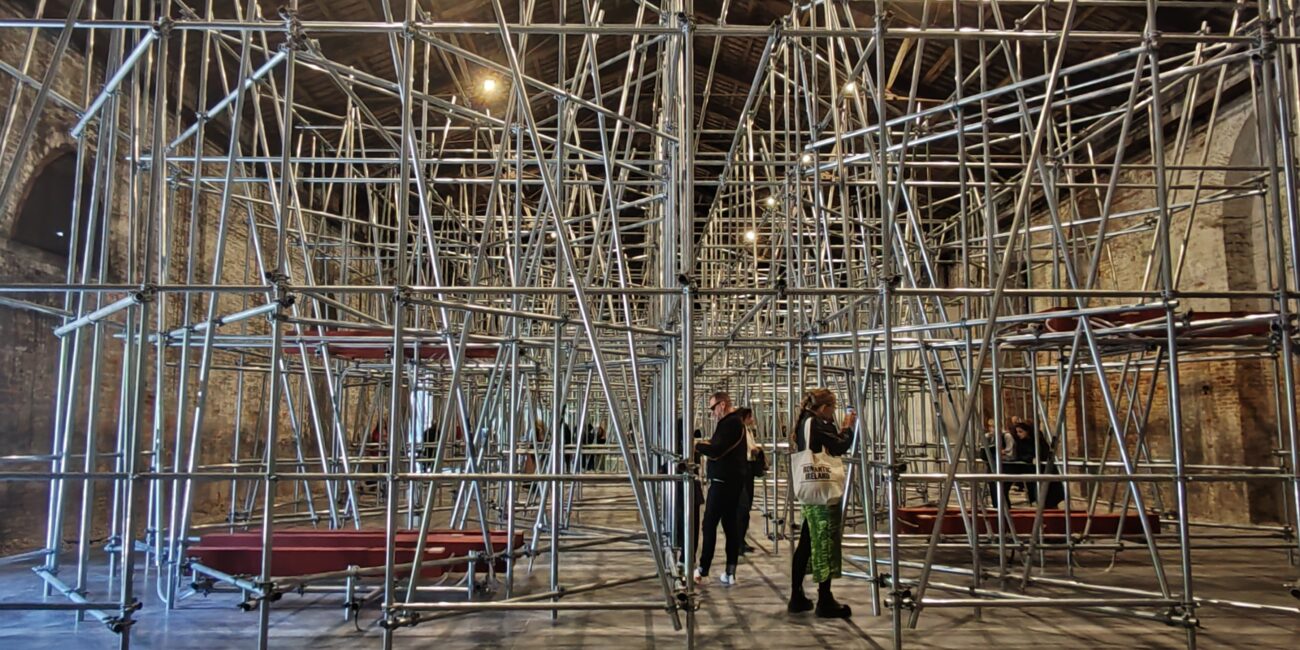
Italian Pavilion by Lidija Ristić
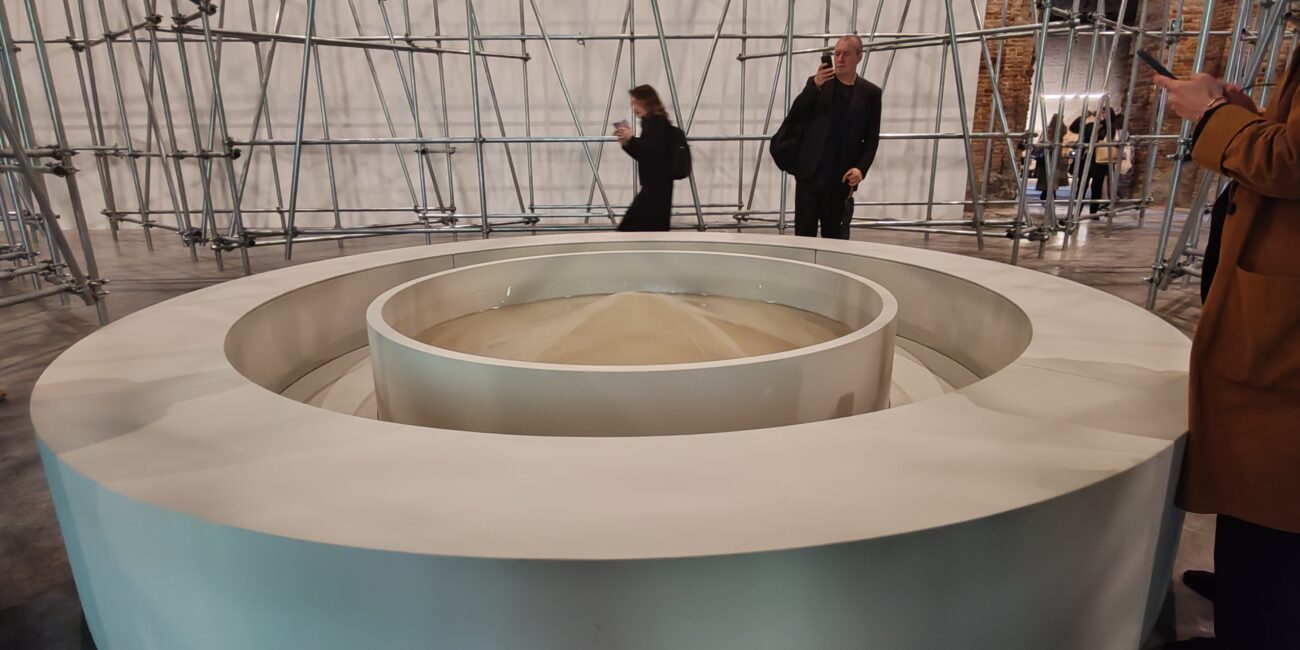
Italian Pavilion by Lidija Ristić
Luxembourg
“A Comparative Dialogue Act” challenges the traditional concept of artistic authorship, presenting a collaborative exploration of sound as a medium. Through a series of residencies during the Biennale, artists are contributing to a shared body of work, transforming the pavilion into a space of collective creativity. The exhibition aims to transcend singular perspectives of sound, fostering connection and understanding through diverse sonic languages. The project involves four artists creating individual sound libraries, which are shared and appropriated throughout the Biennale to produce collaborative soundscapes. Performances, integral to the collective artwork, will showcase each artist’s contribution. Despite never physically meeting, the artists’ explorations intersect, creating a cyclic process of synthesis and trust. The pavilion itself serves as an infrastructure for sound transmission, with movable sound walls and a vibrating floor tuned to the walls’ frequencies. The physical space evolves throughout the Biennale, reflecting the ongoing dialogue and appropriation.
Through a series of residencies during the Biennale, artists are contributing to a shared body of work, transforming the pavilion into a space of collective creativity.
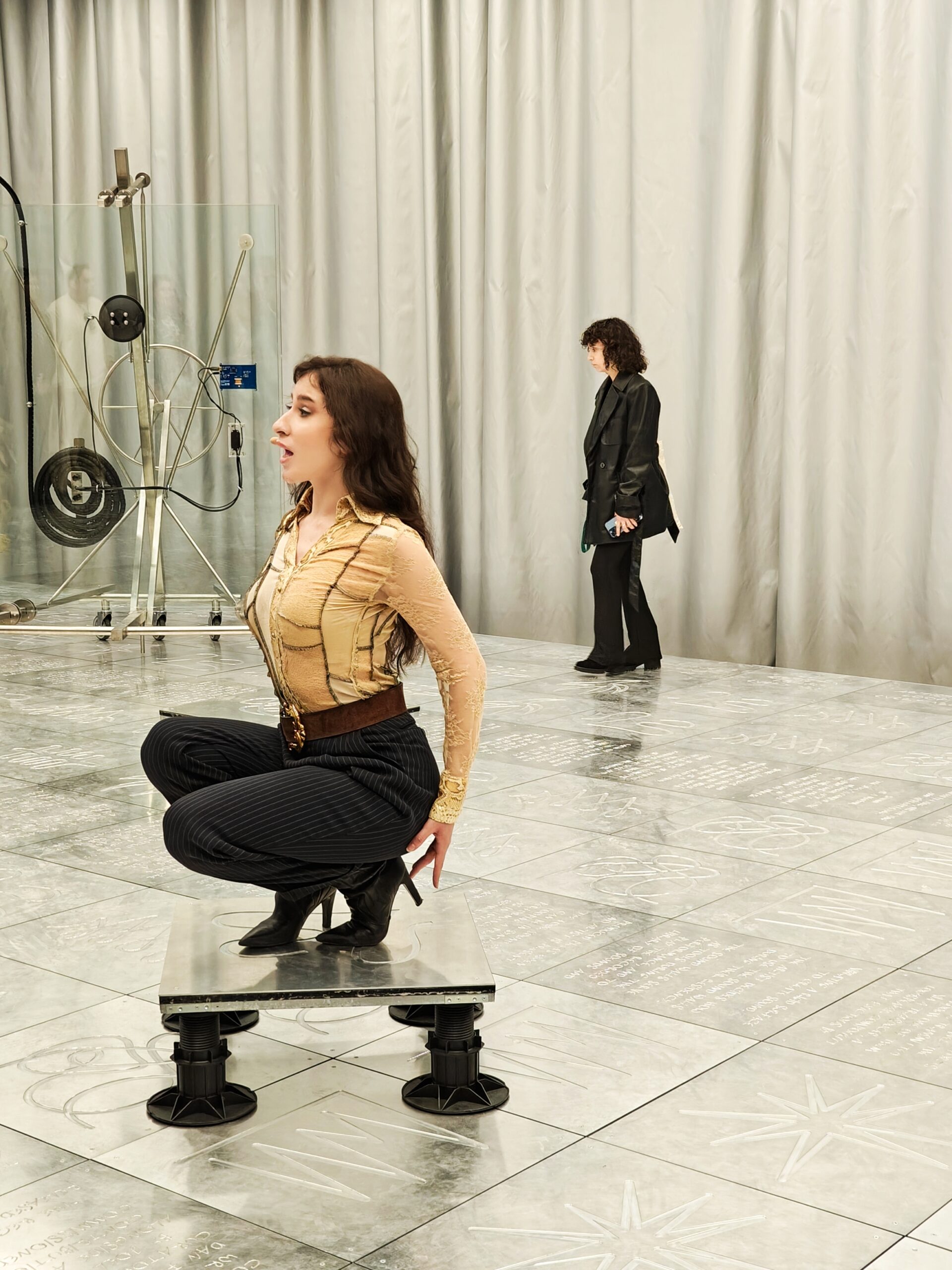
Luxenburg Pavilion by Milica Grujić
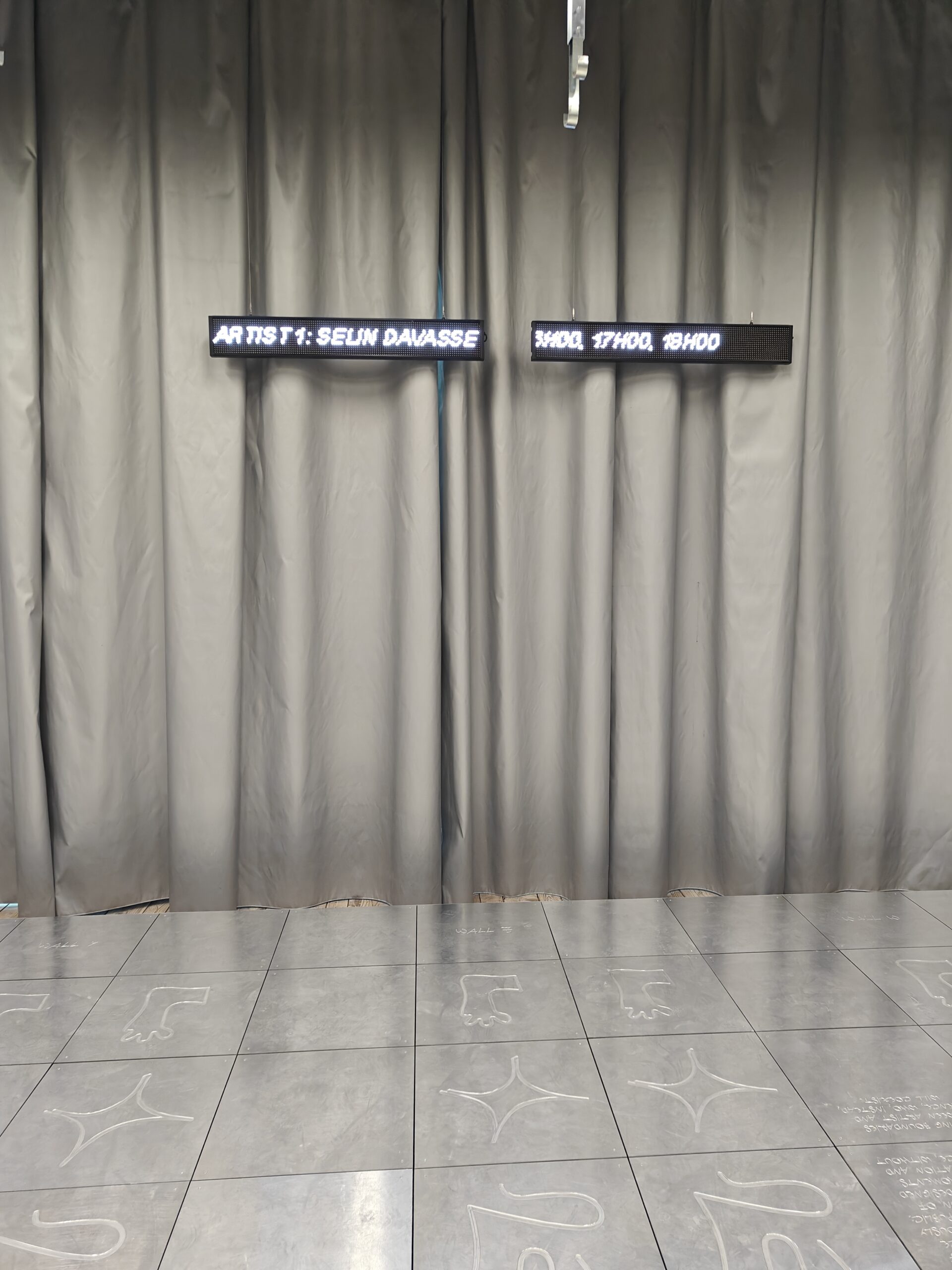
Luxenburg Pavilion by Milica Grujić
Events of Note Transpiring at the 60th Venice Biennale
Bolivia at the Russian Pavilion
For a second consecutive Biennale (since the outbreak of the war with Ukraine), the Russian delegation has opted out of presenting in Venice. However, this year they graciously gave their otherwise vacant pavilion to Bolivia. In the past Bolivia’s pavilion has been in the Cannaregio neighborhood of Venice, far removed from the main Biennale exhibitions spaces.
Protest in support of a Ceasefire in Gaza
Art Not Genocide Alliance staged a demonastration outside the United States Pavilon and denounced complicity of both the Italian and US governments in the on-going conflict. Among the multilingual chats, the protesters called for “No Art Washing!”
The Israeli pavilion [some-what] closed
After much criticism and activism decried Israel’s inclusion at the Biennale, (including a petition with over 24,000 signatures) the artist bowed to public pressure and left the glass doors of the fully installed pavilion, together with looping video works on view, locked. However, Israeli-native Bartana from the artistic duo presenting at the German pavilion, did not come under nearly as much fire.
Many first time exhibitors at the Biennale
Republic of Benin, Ethiopia, Panama, Democratic Republic of Timor Leste, and United Republic of Tanzania are exhibiting for the first time this year at the Venice Biennale. In addition many long-time participants appointed young emerging artists to represent their pavilions: Greece, Uzbekistan and France, among others.


